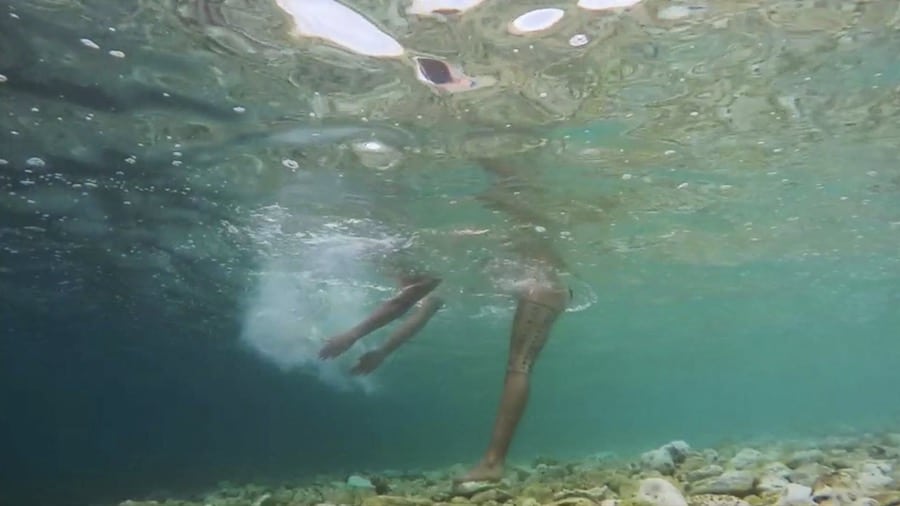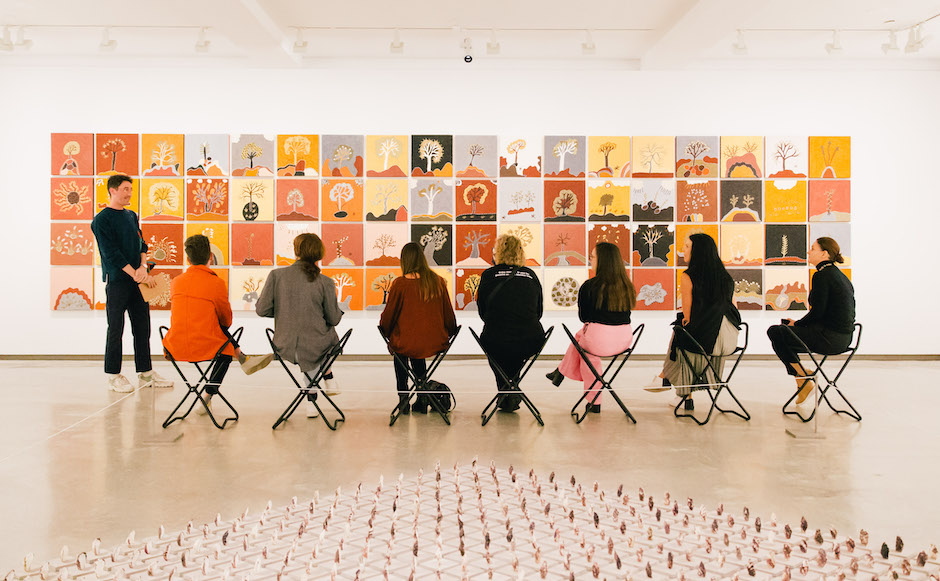How can the arts contribute to people’s wellbeing? In the wake of the pandemic it’s a question that is being pondered by everyone from major arts institutions to individual art and music therapists.
Artists have long used their creative practice to process and express emotion, and now it seems the world is waking up to what the arts could offer people struggling to keep their wellbeing on an even keel.
Last month, Sydney’s Museum of Contemporary Art (MCA) launched a series of 45-minute sessions designed to connect people with their emotions through the medium of art.
Dubbed Art Flow, the twice-daily sessions on Thursdays and Saturdays are aimed at uplifting the languishing office worker and drawing in the disconnected.
Gill Nicol, Director, Audience Engagement at the MCA, said the sessions, guided by the gallery’s team of 30 artist educators, offer an opportunity for people to connect with themselves and others in small groups.
‘It’s reaching people who are just feeling more vulnerable and scared,’ she said.
The sessions, created in collaboration with Melbourne health, wellbeing, and performance psychology practice The Mind Room, begin with a five-minute Acknowledgement of Country to bring people into a place of presence.
Then an artwork is used as a conduit for a guided conversation. Initially, the four works are Angela Tiatia, Lick, 2015; Elizabeth Mipilanggurr, Bamagora (conical pandanus palm mat), 2001; Nicholas Mangan, A World Undone, 2012; and Khadim Ali, The Haunted Lotus, 2011-2012.
Dr Jo Mitchell from The Mind Room said it is hoped the sessions will help people to manage their wellbeing better by understanding their emotions.
‘The sessions are designed to normalise all emotions – good, bad, and ugly – and to help people to process them by describing them, as you would an artwork, with colour, texture, weight, and shape, and eventually naming them,’ Mitchell explained.
‘We know that the act of naming our emotions helps us to savour or tame them – depending on what people need.’
Read: New report confirms arts’ benefits for health, aging and wellbeing
Nicol said Art Flow, conceived in the wake of drought, bushfires, floods, and the discombobulating pandemic lockdowns, builds on the gallery’s wellbeing learnings from its art and dementia program. A pilot version was tested out on MCA staff.
The next phase will be a six-week course for initial participants wanting to deepen their exploration. The two-hour experience will include a making component.
Inviting people to express their emotions can get difficult and messy. Despite the emotional content, Nicol was emphatic Art Flow is not intended to be art therapy.

The MCA has been conscious of creating safe spaces for everyone involved, including its artist educators, so they can confidently navigate the line between facilitating people to express emotion and taking on the role of a therapist.
‘That’s probably the difference to the many other wellbeing programs that are going on around the world – they are embedded in an art therapy basis and we are not doing that,’ Nicol said.
Art and wellbeing around the world
The exploration of how the arts can contribute to wellbeing has come to the forefront for many organisations in recent years.
In September 2021, the Metropolitan Museum of Art in New York and the World Health Organization Arts and Health Program joined forces to launch Healing Arts New York. Several months of programming culminated in a symposium bringing together artists, healthcare workers, researchers, and policymakers to discuss global arts and health research, practice, and policy implementation.
In Canada, the Montreal Museum of Fine Arts (MMFA) offers ‘museotherapy’ programs, has art therapists on staff, and invites people to use its free art studio, Art Hive. In 2016 it opened a dedicated space: the Michel de la Chenelière International Atelier for Education and Art Therapy, and it runs a wide range of projects designed for people with eating disorders or young people with speech disorders, for example.
Since 2018 doctors who are members of Médecins francophones du Canada were able to prescribe visits to the MMFA.
Read: It’s time to talk about spiritual wellbeing
Others are following MMFA’s lead. Later this year Palais de Toyko in Paris will open a ‘care centre’ called HAMO for programs that promote art as a source of wellbeing. The Louvre has also joined forces with two art therapists to launch Louvre-therapy, group workshops that see the museum experience itself as providing health benefits.
In the UK creative health charity Artlift runs participatory arts sessions in doctors’ surgeries and community spaces and the Manchester Museum and the Whitworth, and Manchester Art Gallery provide creative arts for health programs, including Creative Writing for Carers, and Muso Baby, an interactive music session for parents and children run by a music therapist.
Scaling up the positives
On home turf the Australia Council is demonstrating the potential for the arts to help address the mental health policy challenge. It held an arts and wellbeing forum in November last year, showcasing 10 organisations using dance, art, or music to address the wellbeing challenge and it is creating a resource centre to share the growing body of evidence and case studies related to arts and mental wellbeing.
The Art Gallery of NSW (AGNSW) has also conducted forays into the area in collaboration with Black Dog Institute. An initial eight-week pilot program with 16 people experiencing mild to moderate depression involved engaging with artworks in the gallery and then creating work that were displayed in the gallery for friends and family.
That program morphed into the 10-week Culture Dose online program during lockdown and drew 50 to 60 participants on a weekly basis.
At the Australia Council forum, Dr Katherine Boydell, professor of mental health, Black Dog Institute, said the issue now is not to gather more evidence of the efficacy of such programs but how to scale them up.
Individuals are also developing programs. In North Queensland, arts educator Sandy Guy has launched a six-week course, Sculpt Your Mind, using art to help people develop a healthier mindset.
To create the program, she drew on her experience running creative and personal development programs using cognitive behaviour therapy (CBT) and acceptance therapy, work in Catholic schools, and some art therapy training.
‘Mindset is so important. It has such an impact on your life and how you relate to life and how you deal with life,’ said Guy.
Read: Does the arts sector need more creative therapists?
Her program in Townsville shares art-centred mindfulness tools with participants to train their brains and develop healthier neural pathways. ‘It’s drawing awareness to those thoughts and feelings that come up and giving them tools to deal with that.
‘If they start feeling anxious, they can use the tools to ground themselves,’ she said.
The program, which will run again from 5 August, is having an impact.
‘One of the by-products of the program is that the women talk about things, things that they haven’t talked about. We had a lady who was in tears telling us this story,’ Guy said.
‘It’s not only the shared experience with the artmaking but sharing their own personal experiences as well. It gives them that space. That’s huge for healing.’





